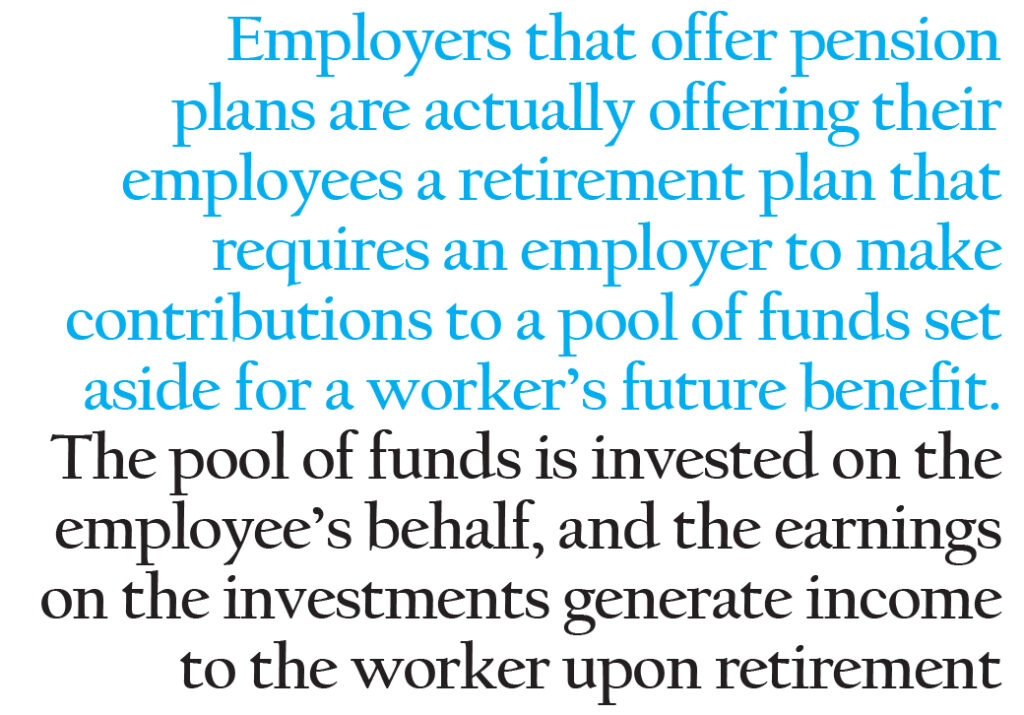It was at a seminar organized by the SDPI on pension reforms that it struck me just how grave the issue of pension liability has gotten. Generally, I had always been aware about the seriousness of the issue and its implications for government and public sector entities.
I had been invited to the panel discussion because of my experience on the board of various public sector entities and my work on tapping long term project finance funding through capital market instruments. However, this panel discussion became eye-opening. The pension issue is not just one that is a growing financial burden, but it is also one that has a direct impact on the performance of the government and it’s delivery, because of the effect it has on the performance of civil servants. This was what inspired me to dive in head-first on the topic of pension reform, and if there is one thing I have learned, it is this: in one way or the other, pension reforms affect all of us.
The pension problem
Let us begin with some context to understand the extent of the challenge that faces us in the shape of a rising pension bill. Just in the past year, the federal pension bill has increased from Rs 150 billion in 2020 to Rs 480 billion in 2021. Now, very basically, this means that the government or any public sector company for that matter has a pension bill that they need to pay off, and they need to be making money for that. The government’s main source of revenue is taxation, and they must collect enough to pay salaries to their employees as well as pension to retirees. This is their pension liability – the amount of money that a private company—or a city or state or federal government—has to account for in order to make future pension payments. In other words, a pension liability is the difference between the total amount due to retirees and the actual amount of money the company has on hand to make those payments. According to reports from donors, the federal government’s unfunded liability currently stands at around Rs 3 trillion.
Post the 7th National Finance Commission award, provincial governments’ pension bills have also increased exponentially from Rs 75 billion in 2011 to Rs 500 billion in 2020. This is clearly an unsustainable path. Studies suggest that with no changes to the existing pension arrangements, the federal pension bill will rise to an alarming level of Rs 750 billionn by 2023. Provinces are likely to face similar challenges.
This is a very frightening situation which becomes more complicated due to the presence of fiscal pressures from compromised tax collections, losses by state owned enterprises, accumulating circular debt, and other economic hardships faced by Pakistan. However, the silver-lining is that out of all fiscal challenges that the government faces, this is one that is easier to plug because we have real life examples of how other countries have dealt with the same issues. In the developed world, where life expectancy is much higher and the population is not very young, rising pension liability has been a major issue that has been successfully tackled.
Some pension basics
Before we get into the details about pension scheme options, it is important to understand how pension works. Most people think that a company simply uses a part of its profits to keep giving a monthly or yearly pension to its former employees. In fact, ideally, this is not how pension plans should be working. Employers that offer pension plans are actually offering their employees a retirement plan that requires an employer to make contributions to a pool of funds set aside for a worker’s future benefit. The pool of funds is invested on the employee’s behalf, and the earnings on the investments generate income to the worker upon retirement. A percentage of your pay is put into the pension scheme automatically every payday, and when you retire, you can choose between a lump-sum payout or a monthly “annuity” payment. Employee benefits classify post-employment plans into two categories:
The first category is called Defined Contribution (DC), in which the employer’s liability is limited to the amount that it agrees to contribute to the post-retirement fund, consequently, actuarial risk and investment risk falls on the employee. In other words, the risk of investment performance of the fund, and resultant pension returns, rests with the employee or its representatives. The return could be better or worse depending on market factors and competence of the fund managers. Essentially, this means that when you retire, the company invests your money, usually through their fund managers, and the pay out you receive depends on how well the fund is doing.

The other category is that of Defined Benefit (DB), which is a scheme in which the amount of pension benefit is defined; therefore, all actuarial as well as investment risks are borne by the employer. Irrespective of what the market circumstances are, and if pension liability is funded or not, the employee will get a defined (pre-set) return post retirement; there will be no upside or downside for the employee, unlike in the DC method. This is a more stable payout for employees, and in the case of governments, this is how pension is generally paid after being funded by payroll or other taxes. It is also how pension liabilities are quickly becoming such a burden on the government as the pension bill keeps increasing. This is exactly why this method is beginning to feel outdated and has been changed in many developing countries.
Changing trends
The past three decades show that there have been significant changes in pension schemes in most developed and emerging markets. As per international best practices, the Pakistan Government’s DB and unfunded pension arrangements are out of line. Non-contributory, or DB, schemes are reducing and many countries have switched to DC plans due to financial stress caused by large pension bills.
The advantage of such a switch is that the financing burden can be spread across different periods in a more stable and predictable manner. New accounting standards have helped Governments to better understand the underlying accrued liabilities and the long-term costs of their pension arrangements. DC pension programs, therefore, are replacing DB plans. The DC system by its very nature ensures that the accrual of benefits are fully funded. Thus, employers are guaranteed that no unfunded liabilities would emerge.
However, this could have an adverse impact on employees since the value of their accumulated pension assets are not defined, and because they depend on the investment performance of underlying pension funds. Most importantly, DC schemes allow employees to play a role in the investment decisions. This allows individual risk/reward preferences as well as leaves room for other considerations like wanting to invest only in Islamic securities. The employee will essentially become masters of their own destiny with respect to investment decisions about their retirement benefits, and may fetch more satisfying returns (both financially and otherwise) than they could have under the guaranteed DB system. The DB system is easier and safer, but the DC system is not a burden and it also allows for more freedom.
With enhanced life expectancy and widening fiscal deficits in emerging markets, this problem is becoming more glaring. There are successful examples from countries where the make-up of the society and the community are very similar to Pakistan that have managed to curb the mushrooming concerns around this dilemma. Some of these examples are worth evaluating as possible base models for Pakistan in tackling this issue. The three examples that are the most important and most similar to Pakistan are India, the Philippines, and Thailand.
The most relevant example is India, and they beat us to pension reforms by nearly two decades. All new entrants in the government with effect from 2004 were hired on the National Pension System, a DC pension arrangement into which 10% of pay is contributed by both the employee and the employer. Those hired prior to 2004 continue to receive pension benefits based on the earlier DB pension program. In 1997, the Philippines set up an institution called the Government Service Insurance System (GSIS), which provides DB retirement benefits. Employees pay 9% of their salary to GSIS and the employer adds another 12%. Retirement benefits are determined based on age and years of contribution and are a combination of lump-sum amount and lifetime annuity. In Thailand, for new hires starting 1997, parametric changes were made in the DB pension method, supplementing it with a DC pension arrangement to which employee and employer contribute 3% each. Therefore, Pakistan has ample instances to draw on, in order to box-in this looming crisis of sorts at the Government level.

There are, however, some islands of excellence in this space within our own country, albeit on a micro-level, and that also in the public sector only, which shall be looked at, celebrated and encouraged in other public sector entities. The Oil & Gas Development Company Limited (OGDCL) management and board, in June 2016, took cognizance of the menacing situation of ballooning pension liability for the company, which was posing an unprecedented threat to cash flows and sustainability of the pension scheme itself. So they decided to rationalize the pay package and introduced far-reaching changes in the structure of both pay and pension, as they both go hand in hand and cannot be separated.
Accordingly, maximum salary caps were introduced for each pay-scale, which by default put a check on the extent of extreme liability for each grade of employee, plus started creating much-needed difference between performers and non-performers within the organization. Concurrently, effective since 1st January 2016, DB pension formula was discontinued for new inductees. While existing employees continued to enjoy protection of their terms & condition of service, including DB pension entitlement, new inductees have been governed under a gratuity scheme which does not put the company under any long term obligation. As a result of foregoing steps, at that time, actuaries worked out a cumulative benefit of Rs. 186bn to OGDCL in the form of savings in salaries and pension contribution over the next 10 years.
What is to be done
Based on the above, it can be concluded that on the fiscal management front, Pension Reforms are “low hanging fruit in relative terms” and could be fixed while keeping a few basic considerations in mind. The first and most important step is that there must be political will to get this done. Once it is established that this is there, tried and tested solutions could be borrowed from across the globe. All new hiring in the government shall be under DC system immediately with restructured pay-scales having ranges backed by pension fund management structure.
Other than maximum salary and pension entitlement capping, halt on retrospective increase in future retirees, and (subject to legal provisions) cull the number of pension beneficiaries; extending retirement age, or providing fewer benefits in early retirements are options which could be implemented in the existing DB plans as a package. There is no argument that pension funds need to be developed in Pakistan, and pension liability of the Government is required to be funded. There has to be a plan which should be managed through a pension fund regime only.
Existing DB pension liability shall be funded through a combination of in-kind assets of the Government (for example, existing properties/ offices given to pension funds and rented back by the Government, lands could be handed to funds for development, etc.) and in-cash, albeit in tranches, as funding in one-go is not possible, as Government is in borrowing mode and that would put unnecessary debt burden on the Country. This plan ticks lots of boxes, with the biggest box being conversion of dead assets into earning ones.
What this does for Pakistan
Pension Funds have multifaceted benefits for any country. With regards to Capital Market Development, the assets of OECD countries’ in pension assets stood at over US$ 33 trillion (38% of Global GDP) in 2020. The US has the largest pension assets (88% of GDP), followed by the UK (123% of GDP), Australia (132% of GDP) and Switzerland (143% of GDP).
Pension funds are also the biggest investors in the global equity and bond markets, contributing 70% of the market capitalization in some of the OECD markets. Unfunded government pension arrangements are a key factor for the low depth in our bond and equity markets. And since they are also used for real estate and mortgage funding, this means real estate developments will help grow the market for pension funds and vice versa. Most important will be the growth in long term debt markets through a pick-up in housing market mortgages as they require purchase value of the home to be spread out over around twenty years or more, at a fixed rate. Buyers of such long-term Fixed Rate bonds are typically pension and life insurance fund managers. This whole idea fits perfectly with the Government’s vision of promoting housing and construction activities, particularly low cost housing.
They will also give enhanced saving options. In Pakistan, the overall saving rates are one of the lowest in the world. In 2020, the national savings fell below 10% of GDP. Even the Bond markets in Pakistan are small at less than 5% of GDP. Corporate bond markets are virtually non-existent, which will be given a necessary boost by active pension funds; thus, offering safe & secure saving products to the general public.
Pension funds also offer an alternative to the Government’s Public Sector Development Program (PSDP). Pension funds, by their very nature of return requirements, typically have long term liquidity and appetite for high risk assets which generally are out of the scope of banks. A robust pension fund regime would mitigate the fiscal pressure on the Government for funding important infrastructure projects with long gestation periods.
On the investment in commerce and industry front, if we look around the globe, pension funds own large businesses and industries; thus, offering a very solid partnership opportunity for local and international investors to promote trade and commerce and create jobs. These funds also encourage the development of universal health insurance schemes, which can be launched by the province under the Assets Under Management (AUMs) of the insurance companies, a key component of the pension arrangements in most countries.
Note of thanks: I feel obliged to thank my colleagues, Sayem Ali and Irteza Qureshi, who had done the research for me on this very critical topic which helped me realize how this existing/emerging fiscal burden could be addressed.


























A very important issue highlighted which needs to be addressed immediately otherwise just like Circular Debt this will become another white elephant which will require borrowing by the central govt to pay pensions.
Who will look after helpless/hapless old aged retirees if they have to live beyond 60 years? Trouble shooters come on surface with human friendly solutions. Always watching two systems one is supporting mighty and other is ruining weak. Even today we see huge pension takers like judges, generals, bureaucracy, retired government servants and on the other hand NO pension for bankers etc…
It means that corporate education, study, knowledge, profession is deaf, dumb and fruitless to address this issue without cruelty.
With various economic challenges to the govt including ever increasing Circular Debt, Loss Making PSEs, loan & interest payments, among others, there is very very limited room for the govt to keep paying pensions. Moreover govt should seriously bench mark the employee salary with that of the private sector to discourage corruption along with annual appraisal cycle and discontinue with the pension system altogether.
as usual, an important issue is addressed in the article. we should hope that once a voice/concern is being raised from an individual, enjoying an elevated post, it will not remain unheard.
This is a very important issue and rightly highlighted.
The Federal Government should make armed forces, judicual and other retirees’ pensions and benefits from the budget allocated to the armed forces and same with the judiciary and elsewhere. It would ensure that a true picture of organizational expenses and liabilities is presented in each budget.
I would also suggest Profit to guide vast hordes of private sector employees in their readership about potential options to avail for generating their own pensions in old age from various investments avenues.